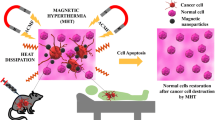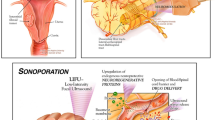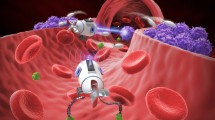Abstract
Recent advances in technology have led to an increase in the detection of previously undetected deep-located tumor tissue. As a result, the medical field is using a variety of methods to treat deep-located tumors, and minimally invasive treatment techniques are being explored. In this study, therapeutic effect of microwave ablation (MWA) on tumor generated inside liver tissue was analyzed through numerical analysis. The distribution of electromagnetic fields in biological tissues emitted by microwave coaxial antenna (MCA) was calculated through the wave equation, and the thermal behavior of the tissue was analyzed through the Pennes bioheat equation. Among various treatment conditions constituting MWA, tumor radius and the slot length inside the MCA were changed, and the resulting treatment effect was quantitatively confirmed through three apoptotic variables. As a result, each tumor radius has optimal power condition for MWA, 2.6W, 2.4W, and 3.0W respectively. This study confirmed optimal therapeutic conditions for MWA. Three apoptotic variables were used to quantitatively identify apoptotic temperature maintenance inside tumor tissue and thermal damage to surrounding normal tissue. The findings of this study are expected to serve as a standard for treatment based on actual MWA treatment.
Graphical abstract












Similar content being viewed by others
Abbreviations
- c :
-
Speed of light (m/s)
- c p :
-
Specific heat (J/kgK)
- \(\overrightarrow{E}\) :
-
Electric field (V/m)
- f :
-
Frequency (Hz)
- \(\overrightarrow{H}\) :
-
Magnetic field (A/m)
- k m :
-
Thermal conductivity (W/mK)
- k p :
-
Propagation constant (1/m)
- l s :
-
slot length (m)
- P m :
-
Microwave input power (W)
- r :
-
Radius (m)
- t :
-
time (s)
- T :
-
Temperature (K)
- Z :
-
Wave impedance (Ω)
- ε 0 :
-
Relative vacuum permittivity (F/m)
- ε r :
-
Relative permittivity
- \({\theta}_A^{\ast }\) :
-
Apoptosis retention ratio
- \({\theta}_{eff}^{\ast }\) :
-
Effective apoptosis retention ratio
- \({\theta}_H^{\ast }\) :
-
Thermal hazard retention value
- λ :
-
Wavelength [m]
- μ :
-
Permeability (H/m)
- μ r :
-
Relative permeability
- ρ :
-
Density (kg/m3)
- σ :
-
Electric conductivity (S/m)
- φ s :
-
Slot length ratio
- ω :
-
Angular frequency (rad/s)
- ω b :
-
Blood perfusion rate (1/s)
- b :
-
Blood
- inner :
-
Inner
- outer :
-
Outer
- met :
-
Metabolism
- mw :
-
Microwave
- r, φ, z :
-
Notation of direction
- t :
-
Tumor tissue
- 0:
-
Free space
References
Crawford S (2013) Is it time for a new paradigm for systemic cancer treatment? Lessons from a century of cancer chemotherapy. Front Pharmacol 4:68. https://doi.org/10.3389/fphar.2013.00068
Khalil DN, Smith EL, Brentjens RJ, Wolchok JD (2016) The future of cancer treatment: immunomodulation, CARs and combination immunotherapy. Nat Rev Clin Oncol 13(5):273–290. https://doi.org/10.1038/nrclinonc.2016.25
Lei N, Gong C, Qian Z, Luo F, Wang C, Wang H, Wei Y (2012) Therapeutic application of injectable thermosensitive hydrogel in preventing local breast cancer recurrence and improving incision wound healing in a mouse model. Nanoscale 4(18):5686–5693. https://doi.org/10.1039/c2nr30731f
Waks AG, Winer EP (2019) Breast cancer treatment: a review. Jama 321(3):288–300. https://doi.org/10.1001/jama.2018.19323
Horvath KA, Acker MA, Chang H et al (2013) Blood transfusion and infection after cardiac surgery. Ann Thorac Surg 95(6):2194–2201. https://doi.org/10.1016/j.athoracsur.2012.11.078
Shiroky J, Lillie E, Muaddi H, Sevigny M, Choi WJ, Karanicolas PJ (2020) The impact of negative pressure wound therapy for closed surgical incisions on surgical site infection: a systematic review and meta-analysis. Surgery 167(6):1001–1009. https://doi.org/10.1016/j.surg.2020.01.018
Fallahi H, Clausing D, Shahzad A, O’Halloran M, Dennedy MC, Prakash P (2019) Microwave antennas for thermal ablation of benign adrenal adenomas. Biomed Phys Eng Express 5(2):025044. https://doi.org/10.1088/2057-1976/ab068b
Nguyen PT, Abbosh A, Crozier S (2016) Three-dimensional microwave hyperthermia for breast cancer treatment in a realistic environment using particle swarm optimization. IEEE Trans Biomed Eng 64(6):1335–1344. https://doi.org/10.1109/TBME.2016.2602233
Galema SA (1997) Microwave chemistry. Chem Soc Rev 26(3):233–238. https://doi.org/10.1039/CS9972600233
D’arcy MS (2019) Cell death: a review of the major forms of apoptosis, necrosis and autophagy. Cell Biol Int 43(6):582–592. https://doi.org/10.1002/cbin.11137
Zhao YY, Wu Q, Wu ZB, Zhang JJ, Zhu LC, Yang Y, Ma SL, Zhang SR (2018) Microwave hyperthermia promotes caspase-3-dependent apoptosis and induces G2/M checkpoint arrest via the ATM pathway in non-small cell lung cancer cells. Int J Oncol 53(2):539–550. https://doi.org/10.3892/ijo.2018.4439
Liao S, Hu X, Liu Z, Lin Y, Liang R, Zhang Y, Li Q, Li Y, Liao X (2019) Synergistic action of microwave-induced mild hyperthermia and paclitaxel in inducing apoptosis in the human breast cancer cell line MCF-7. Oncol Lett 17(1):603–615. https://doi.org/10.3892/ol.2018.9629
Bottiglieri A, Ruvio G, O’Halloran M, Farina L (2020) Exploiting tissue dielectric properties to shape microwave thermal ablation zones. Sensors 20(14):3960. https://doi.org/10.3390/s20143960
Selmi M, Bin Dukhyil AA, Belmabrouk H (2019) Numerical analysis sof human cancer therapy using microwave ablation. Appl Sci 10(1):211. https://doi.org/10.3390/app10010211
Gangadhara B, Mariappan P (2023) A vector finite element approach to temperature dependent parameters of microwave ablation for liver cancer. Int J Numer Method Biomed Eng 39(1):e3661. https://doi.org/10.1002/cnm.3661
Kernot D, Yang J, Williams N, Thomas T, Ledger P, Arora H, van Loon R (2023) Transient changes during microwave ablation simulation: a comparative shape analysis. Biomech Model Mechanobiol 22(1):271–280. https://doi.org/10.1007/s10237-022-01646-6
Kim D, Kim H (2021) Induction of apoptotic temperature in photothermal therapy under various heating conditions in multi-layered skin structure. Int J Mol Sci 22(20):11091. https://doi.org/10.3390/ijms222011091
Yang D, Converse MC, Mahvi DM, Webster JG (2007) Expanding the bioheat equation to include tissue internal water evaporation during heating. IEEE Trans Biomed Eng 54(8):1382–1388. https://doi.org/10.1109/TBME.2007.890740
Cepeda M, Vera A, Leija L Trujillo C (2008) Coaxial double slot antenna design for interstitial hyperthermia in muscle using a finite element computer modeling, IEEE Instrum Meas Technol Conf 961–963. https://doi.org/10.1109/10.1109/IMTC.2008.4547175
Keangin P, Rattanadecho P, Wessapan T (2011) An analysis of heat transfer in liver tissue during microwave ablation using single and double slot antenna. Int Commun Heat Mass Transf 38(6):757–766. https://doi.org/10.1016/j.icheatmasstransfer.2011.03.027
Simanovskii DM, Mackanos MA, Irani AR, O’Connell-Rodwell CE, Contag CH, Schwettman HA, Palanker DV (2006) Cellular tolerance to pulsed hyperthermia. Phys Rev E 74(1):011915. https://doi.org/10.1103/PhysRevE.74.011915
Hall SK, Ooi EH, Payne SJ (2015) Cell death, perfusion and electrical parameters are critical in models of hepatic radiofrequency ablation. Int J Hyperth 31(5):538–550. https://doi.org/10.3109/02656736.2015.1032370
Wang T, Zhao G, Qiu B (2015) Theoretical evaluation of the treatment effectiveness of a novel coaxial multi-slot antenna for conformal microwave ablation of tumors. Int J Heat Mass Transf 90:81–91. https://doi.org/10.1016/j.ijheatmasstransfer.2015.06.030
Brace CL (2008) Temperature-dependent dielectric properties of liver tissue measured during thermal ablation: toward an improved numerical model. Annu Int Conf IEEE Eng Med Biol Soc 230–233. https://doi.org/10.1109/IEMBS.2008.4649132
Wu C, Huang H, Liu Y, Chen L, Yu S, Moser MAJ, Zhang W, Fang Z, Zhang B (2023) Optimal design of aperiodic tri-slot antennas for the conformal ablation of liver tumors using an experimentally validated MWA computer model. Comput Methods Prog Biomed 242:107799. https://doi.org/10.1016/j.cmpb.2023.107799
Pennes HH (1998) Analysis of tissue and arterial blood temperatures in the resting human forearm. J Appl Physiol 85(1):5–34. https://doi.org/10.1152/jappl.1998.85.1.5
Satish V, Repaka R (2023) Microwave ablation trocar for ablating cancerous tumors: a numerical analysis. Med Biol Eng Comput 61(5):1113–1131. https://doi.org/10.1007/s11517-023-02781-7
Rattanadecho P, Keangin P (2013) Numerical study of heat transfer and blood flow in two-layered porous liver tissue during microwave ablation process using single and double slot antenna. Int J Heat Mass Transf 58(1-2):457–470. https://doi.org/10.1016/j.ijheatmasstransfer.2012.10.043
Selmi M, Bajahzar A, Belmabrouk H (2022) Effects of target temperature on thermal damage during temperature-controlled MWA of liver tumor. Case Stud Therm Eng 31:101821. https://doi.org/10.1016/j.csite.2022.101821
Chiang J, Hynes KA, Bedoya M, Brace CL (2013) A dual-slot microwave antenna for more spherical ablation zones: ex vivo and in vivo validation. Radiology 268(2):382–389. https://doi.org/10.1148/radiol.13122128
Huang X, Zhou Y, Liu Z, Qiu B (2022) Design of a closed dual-slot antenna for spherical hepatic microwave ablation. Int J RF Microw Comput Aided Eng 32(3):e23009. https://doi.org/10.1002/mmce.23009
Ge M, Jiang H, Huang X, Zhou Y, Zhi D, Zhao G, Chen Y, Wang L, Qiu B (2018) A multi-slot coaxial microwave antenna for liver tumor ablation. Phys Med Biol 63(17):175011. https://doi.org/10.1088/1361-6560/aad9c5
Brace CL (2011) Dual-slot antennas for microwave tissue heating: parametric design analysis and experimental validation. Med Phys 38(7):4232–4240. https://doi.org/10.1118/1.3601019
Chamani F, Pyle MM, Shrestha TB, Sebek J, Bossmann SH, Basel MT, Sheth RA, Prakash P (2023) In vitro measurement and mathematical modeling of thermally-induced injury in pancreatic cancer cells. Cancers 15(3):655. https://doi.org/10.3390/cancers15030655
Funding
This work was supported by the National Research Foundation of Korea (NRF) grant funded by the Korea government (NSIT) (No. NRF-2022R1A2C2012470).
Author information
Authors and Affiliations
Corresponding author
Ethics declarations
Ethics approval and consent to participate
Not applicable.
Consent for publication
Not applicable.
Competing interests
The authors declare no competing interests.
Additional information
Publisher’s note
Springer Nature remains neutral with regard to jurisdictional claims in published maps and institutional affiliations.
Rights and permissions
Springer Nature or its licensor (e.g. a society or other partner) holds exclusive rights to this article under a publishing agreement with the author(s) or other rightsholder(s); author self-archiving of the accepted manuscript version of this article is solely governed by the terms of such publishing agreement and applicable law.
About this article
Cite this article
Kim, H., Kim, D. Numerical study of the induction of intratumoral apoptosis under microwave ablation by changing slot length of microwave coaxial antenna. Med Biol Eng Comput (2024). https://doi.org/10.1007/s11517-024-03068-1
Received:
Accepted:
Published:
DOI: https://doi.org/10.1007/s11517-024-03068-1




